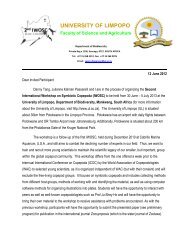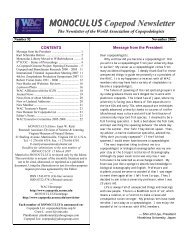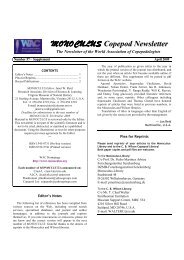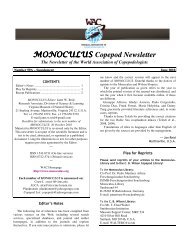Vrede, T. & K. Vrede. 2005. Contrasting ‘top-down’ effects<strong>of</strong> crustacean zooplankton grazing on bacteria andphyt<strong>of</strong>lagellates. Aquatic Ecology 39(3):283-293.Wagner, F.H. & C. Beisser. 2005. Does carbon enrichmentaffect hyporheic invertebrates in a gravel stream?Hydrobiologia 544(1):189-200.Walker-Smith, G.K. 2005. Review <strong>of</strong>: CrustaceanaMonographs 3 (2004). Subterranean Copepoda fromArid Western Australia. Journal <strong>of</strong> Crustacean Biology25(3):533.Walter, T., S. Piepiorka & N. Reimann. 2005. ParasitischeRuderfusskrebse-wichtige Schaedlinge anMeeresfischen. Significant parasitic copepod pests <strong>of</strong>marine fish. DATZ 58(6):64-67. [In German.]Wang, G., X. Jiang, S. Li, L. Wu & D. Wu. 2005. Apotential source <strong>of</strong> recruitment <strong>of</strong> Acartia pacificanauplii: viable benthic resting eggs. Acta OceanograficaSinica 24(2):151-158.Wang, S., T.V. Phong, N. Tuno, H. Kawada & M. Takagi.2005. [Sensitivity <strong>of</strong> two copepod species to an insectgrowth regulator, Pyriproxyfen.] Medical Entomologyand Zoology 56(2):180. [In Chinese.]Wang, X. & W.-X. Wang. 2005. Uptake, absorptionefficiency and elimination <strong>of</strong> DDT in marinephytoplankton, copepods and fish. EnvironmentalPollution 136(3):453-464.Webber, M., E. Edwards-Myers, C. Campbell & D. Webber.2005. Phytoplankton and zooplankton as indicators <strong>of</strong>water quality in Discovery Bay, Jamaica. Hydrobiologia545(1):177-193.Weitere, M., A. Scherwass, K.-T. Sieben & H. Arndt. 2005.Planktonic food web structure and potential carbon flowin the Lower River Rhine with a focus on the role <strong>of</strong>protozoans. River Research and Applications 21(5):535-549.Westheide, W. 2005. Mei<strong>of</strong>auna geographic distribution:vicariance and dispersal. Mei<strong>of</strong>auna Marina 14:201-207.Wiles, S., K. Ferguson, M. Stefanidou, D.B. Young & B.D.Robertson. 2005. Alternative luciferase for monitoringbacterial cells under adverse conditions. Applied andEnvironmental Microbiology 71(7):3427-3432.Willis, K.J., P.A. Gillibrand, C.J. Cromey & K.D. Black.2005. Sea lice treatments on salmon farms have noadverse effects on zooplankton communities: a casestudy. Marine Pollution Bulletin 50(8):806-816.Wilson, S.P. & M.J. Costello. 2005. Predicting futurediscoveries <strong>of</strong> European marine species by using a nonhomogeneousrenewal process. Journal <strong>of</strong> the RoyalStatistical Society, Series C (Applied Statistics)54(5):897-918.Winter, A., G. Swartzman & L. Ciannelli. 2005. Early- tolate-summer population growth and prey consumption byage-0 pollock (Theragra chalcogramma), in two years <strong>of</strong>contrasting pollock abundance near the Pribil<strong>of</strong> Islands,Bering Sea. Fisheries Oceanography 14(4):307-320.40Witthöft-Mühlmann, A., W. Traunspurger & K.O.Rothhaupt. 2005. Meiobenthic response to river-bornebenthic particulate matter a microcosm experiment.Freshwater Biology 50(9):1548-1559.Wonham, M.A., S.A. Bailey, H.J. MacIsaac & M.A. Lewis.2005. Modelling the invasion risk <strong>of</strong> diapausingorganisms transported in ballast sediments. CanadianJournal <strong>of</strong> Fisheries and Aquatic Sciences / JournalCanadien des Sciences Halieutiques et Aquatiques62(10):2386-2398.Woods, J.D. 2005. The Lagrangian Ensemble metamodel forsimulating plankton ecosystems. Progress inOceanography 67(1-2):84-159.Woods, J., A. Perilli & W. Barkmann. 2005. Stability andpredictability <strong>of</strong> a virtual plankton ecosystem createdwith an individual-based model. Progress inOceanography 67(1-2):43-83.Woodson, C.B., D.R. Webster, M.J. Weissburg & J. Yen.2005. Response <strong>of</strong> copepods to physical gradientsassociated with structure in the ocean. Limnology andOceanography 50(5):1552-1564.Xue, Y., X. Jin, B. Zhang & Z. Liang. 2005. Seasonal, dieland ontogenetic variation in feeding patterns <strong>of</strong> smallyellow croaker in the central Yellow Sea. Journal <strong>of</strong> FishBiology 67(1):33-50.Yahel, R., G. Yahel & A. Genin. 2005. Near-bottomdepletion <strong>of</strong> zooplankton over coral reefs: I: diurnaldynamics and size distribution. Coral Reefs 24(1):75-85.Yalynskaya, N.S., I.T. Oleksiv, O.P. Andryushchishin,O.Ya. Dumich, O.P. Yedynak, O.N. Savitskaya & Yu.M.Zabytivskiy. 2005. Hydrobiological indicators <strong>of</strong>toxification <strong>of</strong> ponds <strong>of</strong> the western region <strong>of</strong> Ukraine.Hydrobiological Journal 41(4):103-118.Yamaguchi, A., S. Tachibana, K. Hirakawa & T. Ikeda.2005. Descriptions <strong>of</strong> the copepodid stages <strong>of</strong> themesopelagic copepod, Gaetanus variabilis (Brodsky,1950) (Calanoida, Aetideidae) from the Japan Sea.Crustaceana 78(7):819-837.Yamamoto, Y. & H. Nakahara. 2005. The formation anddegradation <strong>of</strong> cyanobacterium Aphanizomenon flosaquaeblooms: the importance <strong>of</strong> pH, water temperature,and day length. Limnology 6(1):1-6.Yamazaki, A.K. & J.R. Strickler. 2005. Contribution <strong>of</strong>biological studies to the understanding and modeling <strong>of</strong>skilled performance: some examples. In: Khosla, R., R.J.Howlett & L.C. Jain (eds.). Knowledge-Based IntelligentInformation and Engineering Systems: 9th InternationalConference, KES 2005, Melbourne, Australia,September 14-16, 2005, Proceedings, Part IV. LectureNotes in Computer Science 3684:124-128.Ye, S.M., S.J. Gao, Y. Pan, J.Y. Yang & S.L. Li. 2005.Automatic separation system for marine meiobenthosbased on laser-induced fluorescence technology. Journal<strong>of</strong> the Zhejiang University <strong>of</strong> Science 6(6):535-539.Yebra, L., R.P. Harris & T. Smith. 2005. Comparison <strong>of</strong> fivemethods for estimating growth <strong>of</strong> Calanus helgolandicus
later developmental stages (CV–CVI). Marine Biology147(6):1367-1375.Yılmaz, I.N., E. Okus & A. Yüksek. 2005. Evidences forinfluence <strong>of</strong> a heterotrophic din<strong>of</strong>lagellate (Noctilucascintillans) on zooplankton community structure in ahighly stratified basin. Estuarine, Coastal and ShelfScience 64(2-3):475-485.Yoder, H.R. & C.M. Crabtree. 2005. Parasite assemblages inCentrarchid fishes from backwater habitats in southeastTexas, U.S.A. Texas Journal <strong>of</strong> Science 57(1):59-66.Ysebaert, T., M. Fettweis, P. Meire & M. Sas. 2005. Benthicvariability in intertidal s<strong>of</strong>t-sediments in the mesohalinepart <strong>of</strong> the Schelde estuary. Hydrobiologia 540(1-3):197-216.Zafar, A. & N. Sultana. 2005. Zooplankton andmicroinvertebrates <strong>of</strong> River Ganga at Kanpur. UttarPradesh Journal <strong>of</strong> Zoology 25(1):63-66.Zander, C.D. 2005. Comparative studies on goby (Teleostei)parasite communities from the North and Baltic Sea.Parasitology Research 96(1):62-68.Zeldis, J.R., J. Oldman, S.L. Ballara & L.A. Richards. 2005.Physical fluxes, pelagic ecosystem structure, and larvalfish survival in Hauraki Gulf, New Zealand. CanadianJournal <strong>of</strong> Fisheries and Aquatic Sciences / JournalCanadien des Sciences Halieutiques et Aquatiques62(3):593-610.Zhang, B., Q.-S. Tang, X.-S. Jin & Y. Xue. 2005. Feedingcompetition <strong>of</strong> the major fish in the East China Sea andthe Yellow Sea. Acta Zoologica Sinica 51(4):616-623.Zhang, F., S. Sun & Y. Zhang. 2005. Ontogenetic dielvertical distribution <strong>of</strong> the planktonic copepod Calanussinicus in Southern Yellow Sea. Marine Sciences29(9):13-17.Zhang, G.T., S. Sun & F. Zhang. 2005. Seasonal variation<strong>of</strong> reproduction rates and body size <strong>of</strong> Calanus sinicusin the southern Yellow Sea, China. Journal <strong>of</strong> PlanktonResearch 27(2):135-143.Zhang, X., P. Xie, F.Z. Chen, Y.L. Li, S.X. Li, N.C. Guo &J.H. Qin. 2005. Present status and changes <strong>of</strong> thephytoplankton community after invasion <strong>of</strong> Neosalanxtaihuensis since 1982 in a deep oligotrophic plateau lake,Lake Fuxian in the subtropical China. Journal <strong>of</strong>Environmental Sciences China 17(3):389-394.Zhao, W. & S. Dong. 2005. Studies <strong>of</strong> community structureand seasonal dynamics <strong>of</strong> planktonic copepods in salinealkalineponds. Chinese Journal <strong>of</strong> Oceanography andLimnology 23(2):189-193.Zhao, W., M.-p. Zheng, X.-z. Xu, X.-F. Liu, G.-l. Guo & Z.-h. He. 2005. Biological and ecological features <strong>of</strong> salinelakes in northern Tibet, China. Hydrobiologia 541(1):189-203.Ziller, S.R., J.K Reaser, L.E. Neville & K. Brandt (eds.).2005. Especies alienígenas invasoras en Sudamérica:informes nacionales & directorio de recursos. Invasivealien species in South America: national reports &directory <strong>of</strong> resources. Global Invasive Species41Programme, Cape Town, South Africa. 82 pp.http://www.gisp.org/downloadpubs/IASSouthAmericaNatReps.pdf [In Spanish.]Ziliukiene, V. 2005. The diet <strong>of</strong> Abramis brama (L.) larvaereared in illuminated cages. Journal <strong>of</strong> AppliedIchthyology 21(5):406-409.RECENT THESES and DISSERTATIONSAbdallah, Vanessa Doro. 2005. Composição e estrutura dascomunidades parasitárias de Hoplosternum littorale(Hancock, 1828) e Cyphocharax gilbert (Quoy &Gaimard, 1824) do rio Guandu, Estado do Rio deJaneiro, Brasil. 2005. [Composition and structure <strong>of</strong> theparasite communities <strong>of</strong> Hoplosternum littorale(Hancock, 1828) and Cyphocharax gilbert (Quoy &Gaimard, 1824) <strong>of</strong> the Guandu River, State <strong>of</strong> Rio deJaneiro, Brazil.] Dissertação de Mestrado em CiênciasVeterinárias, Universidade Federal Rural do Rio deJaneiro, Seropédica, Rio de Janeiro, Brazil. 65 pp. [InPortuguese.]Alves, Dmitri Ramos. 2005. Composição e estrutura dascomunidades de metazoários parasitos de seis espéciesde escombrídeos (Osteichthyes: Scombridae) do litoraldo Estado do Rio de Janeiro. [Composition and structure<strong>of</strong> the communities <strong>of</strong> metazoan parasites <strong>of</strong> six species<strong>of</strong> scombrids (Osteichthyes: Scombridae) <strong>of</strong> the coast <strong>of</strong>the State <strong>of</strong> Rio de Janeiro.] Tese (Doutorado emCiências Veterinárias), Universidade Federal Rural doRio de Janeiro, Seropédica, Rio de Janeiro, Brazil. [InPortuguese.]Antajan, Elvire. 2005. Rôle des copépodes dans lefonctionnement de l'écosystème à Phaeocystis de la côtesud de la mer du Nord. [Role <strong>of</strong> the copepods in thefunctioning <strong>of</strong> the Phaeocystis ecosystem <strong>of</strong> the southerncoast <strong>of</strong> the North Sea.] Ph.D. Thèse, Vrij UniversitatBrussel, Brussels, Belgium. [In French.]Aygen, C. 2003. Investigation on the Crustacea fauna <strong>of</strong>Isikli Lake (Çivril-Denizli). Ph.D. Thesis, EgeUniversitesi Fen Bilimleri Enstitüsü, Ege, Turkey. 215pp. [In Turkish.]Bandilla, Matthias. 2003. The fish louse Argulus coregoni(Crustacea: Branchiura): Interactions with its host andbacteria. M.Sc. Thesis, University <strong>of</strong> Jyväskylä,Jyväskylä, Finland.Bártholo Maranhão, G.M. 2003. Efeito anthrópico sobre amei<strong>of</strong>auna e nemat<strong>of</strong>auna do ecossistema recifal de Portode Galinhas (Pernambuco: Brasil). [Anthropic effect onthe mei<strong>of</strong>auna and nemat<strong>of</strong>auna <strong>of</strong> the reef ecosystem <strong>of</strong>Porto de Galinhas (Pernambuco: Brazil).] Ph.D. Thesis,Instituto de Oceanografia, Universidade Federal dePernambuco, Recife, Pernambuco, Brazil. 125 pp. [InPortuguese.]Buyukates, Yesim. 2003. Characterization <strong>of</strong> the planktoncommunity in the lower Rincon Delta: investigations
- Page 1 and 2: MONOCULUS Copepod NewsletterThe New
- Page 3 and 4: United States Antarctic Research Pr
- Page 5 and 6: Commission Internationale pour la M
- Page 7 and 8: and Limnology 14(1):17-26.Lavens, P
- Page 9 and 10: Denmark, National Environmental Res
- Page 11 and 12: Wexels Riser, C., P. Wassmann, K. O
- Page 13 and 14: Escribano, R., M. Fernández & A. A
- Page 15 and 16: [Dynamics of the zooplankton commun
- Page 17 and 18: Intergovernmental Oceanographic Com
- Page 19 and 20: Barz, K. & H.-J. Hirche. 2005. Seas
- Page 21 and 22: Capitanio, F.L., M. Pájaro & G.B.
- Page 23 and 24: 2005. Dynamics of ground water cope
- Page 25 and 26: supply of fish larvae and impact of
- Page 27 and 28: Huyer, A., J.H. Fleischbein, J. Kei
- Page 29 and 30: Krśinić, F. 2005. Speleohvarella
- Page 31 and 32: Mastrantuono, L. & T. Mancinelli. 2
- Page 33 and 34: Acartia tonsa: implication for vert
- Page 35 and 36: Alpheus floridanus. Environmental B
- Page 37 and 38: Syndinium turbo (Dinoflagellata, Sy
- Page 39: Troedsson, C., O. Grahl-Nielsen & E
- Page 43 and 44: Kane, Douglas D. 2004. The developm
















